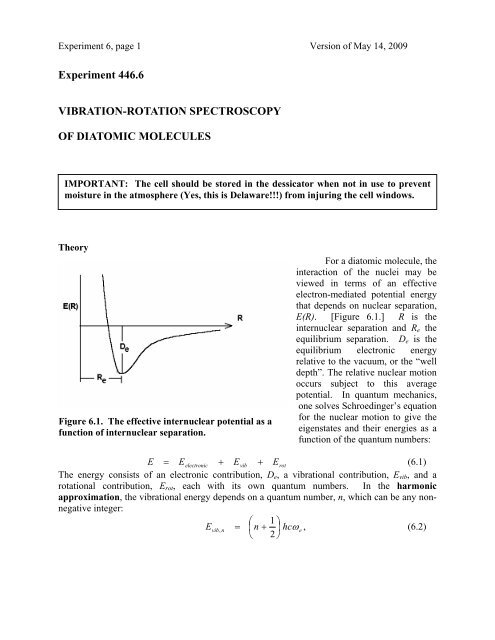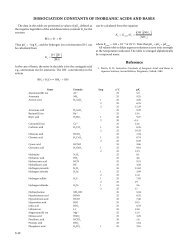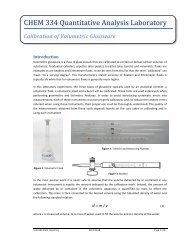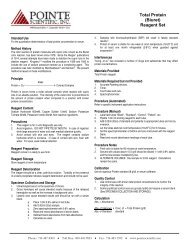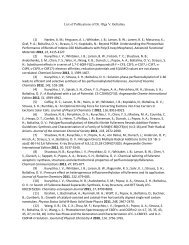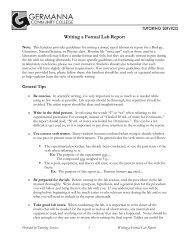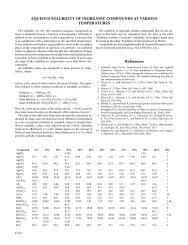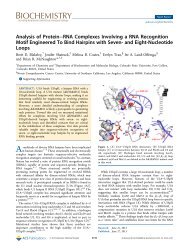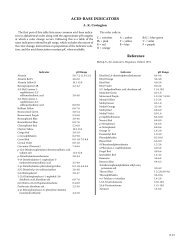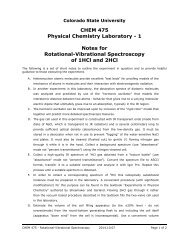Experiment 446.6 VIBRATION-ROTATION SPECTROSCOPY OF ...
Experiment 446.6 VIBRATION-ROTATION SPECTROSCOPY OF ...
Experiment 446.6 VIBRATION-ROTATION SPECTROSCOPY OF ...
You also want an ePaper? Increase the reach of your titles
YUMPU automatically turns print PDFs into web optimized ePapers that Google loves.
<strong>Experiment</strong> 6, page 1 Version of May 14, 2009<br />
<strong>Experiment</strong> <strong>446.6</strong><br />
<strong>VIBRATION</strong>-<strong>ROTATION</strong> <strong>SPECTROSCOPY</strong><br />
<strong>OF</strong> DIATOMIC MOLECULES<br />
IMPORTANT: The cell should be stored in the dessicator when not in use to prevent<br />
moisture in the atmosphere (Yes, this is Delaware!!!) from injuring the cell windows.<br />
Theory<br />
Figure 6.1. The effective internuclear potential as a<br />
function of internuclear separation.<br />
For a diatomic molecule, the<br />
interaction of the nuclei may be<br />
viewed in terms of an effective<br />
electron-mediated potential energy<br />
that depends on nuclear separation,<br />
E(R). [Figure 6.1.] R is the<br />
internuclear separation and R e the<br />
equilibrium separation. D e is the<br />
equilibrium electronic energy<br />
relative to the vacuum, or the “well<br />
depth”. The relative nuclear motion<br />
occurs subject to this average<br />
potential. In quantum mechanics,<br />
one solves Schroedinger’s equation<br />
for the nuclear motion to give the<br />
eigenstates and their energies as a<br />
function of the quantum numbers:<br />
E = Eelectronic + Evib + Erot<br />
(6.1)<br />
The energy consists of an electronic contribution, D e , a vibrational contribution, E vib , and a<br />
rotational contribution, E rot , each with its own quantum numbers. In the harmonic<br />
approximation, the vibrational energy depends on a quantum number, n, which can be any nonnegative<br />
integer:<br />
⎛ 1 ⎞<br />
Evib, n<br />
= ⎜n<br />
+ ⎟ hcω<br />
e<br />
, (6.2)<br />
⎝ 2 ⎠
<strong>Experiment</strong> 6, page 2 Version of May 14, 2009<br />
for which c is the speed of light in free space, and ω e is the fundamental vibrational frequency<br />
determined by the force constant, k, and the reduced mass, µ. 1<br />
1 k<br />
ω<br />
e<br />
= . (6.3)<br />
2πc<br />
µ<br />
The energy in equation (6.2) is correct only if the molecule is subject to a harmonic<br />
k<br />
potential [i.e. V x<br />
2<br />
= ( − xeq ) ]. One can release this assumption through inclusion of<br />
2<br />
anharmonic terms to give a more complete description of the vibrational energy. The resulting<br />
expression for the vibrational energy is a sum of contributions:<br />
2<br />
⎛ 1 ⎞ ⎛ 1 ⎞ ⎛ 1 ⎞<br />
En<br />
= ⎜n<br />
+ ⎟ω e<br />
− ⎜n<br />
+ ⎟ xeω<br />
e<br />
+ ⎜n<br />
+ ⎟ yeω<br />
e<br />
+ ...... (6.4)<br />
⎝ 2 ⎠ ⎝ 2 ⎠ ⎝ 2 ⎠<br />
The additional terms contain energy parameters x e ω e , y e ω e , .... that account for the anharmonicity<br />
of the potential function. Usually only the first correction term is of significance and the sum is<br />
truncated with only the harmonic and first anharmonic terms. Typical data for several diatomic<br />
molecules are given in Table 6.1.<br />
Table 6.1. Ground-state Spectroscopic Constants of Selected Diatomic Molecules a<br />
Molecule ω e /cm -1 x e ω e /cm -1 B e /cm -1 α e /cm -1<br />
1 H 2 4395.2 117.91 60.81 2.993<br />
12 C 16 O 2170.21 13.461 1.9314 0.01748<br />
1 H 79 Br 2649.67 45.21 8.473 0.226<br />
1 H 19 F 4138.52 90.069 20.939 0.770<br />
2 H 19 F 2998.25 45.71 11.007 0.293<br />
a J. H. Noggle, Physical Chemistry, 3 rd Edition, Addison-Wesley-Longmans, New York, 1996.<br />
3<br />
Vibrational Spectroscopy<br />
When a sample is put in contact with a radiation field, it may take up or emit energy by<br />
having molecules change state. The energy exchange only occurs if the energy spacing in the<br />
molecule is equal to the quantum of energy of the field, ω .<br />
E<br />
final<br />
− Einitial<br />
= ω<br />
(6.5)<br />
For the moment consider only changes in vibrational energy of a diatomic molecule such<br />
as HCl or CO. 2 For most molecules, hcω e
<strong>Experiment</strong> 6, page 3 Version of May 14, 2009<br />
Since the ground state is so heavily populated under typical conditions, the dominant feature of<br />
vibrational spectroscopy is the transition from n = 0 to n = 1, called the fundamental. To within<br />
the first anharmonic correction, the energy of the photon necessary to excite this transition is:<br />
∆ Evib<br />
= ω<br />
e<br />
− 2xeω<br />
e<br />
. (6.7)<br />
Transitions in which the energy changes by more than 1 quantum are allowed. For example,<br />
the n = 0 → n = 2 transition is known as the first overtone and occurs at an energy:<br />
∆ Eovertone<br />
= 2ω e<br />
− 6xeω<br />
e<br />
(6.8)<br />
to the same level of approximation.<br />
Single-quantum (∆n = ± 1) transitions from states with n > 0 are allowed, but the smaller<br />
populations of these states make such transitions less intense and more difficult to observe at<br />
room temperature. For example, the transition from the state with n = 1 to the state with n = 2<br />
occurs at<br />
∆ Ehot<br />
= ω<br />
e<br />
− 4xeω<br />
e<br />
(6.9)<br />
This is close to the fundamental. Such transitions are called hot bands because their intensities<br />
increase (relative to the fundamental) as one increases the temperature.<br />
Inclusion of Rotational Transitions<br />
In the foregoing discussion, changes in rotational energy were neglected. To analyze<br />
infrared spectra properly, one must consider the effects of rotational-energy changes, as well as<br />
vibrational-energy changes. In the rigid-rotor approximation, the rotational energy of a diatomic<br />
molecule depends on the rotational quantum number, J, as follows.<br />
2<br />
h 1<br />
E rot , Jm<br />
=<br />
2<br />
2 µ R<br />
J ( J + 1) , (6.10)<br />
where the energy, in this equation, is in ergs or joules.<br />
indicates an average over the vibrational wavefunction. As a first approximation, one<br />
1<br />
treats this as<br />
2<br />
R<br />
e<br />
, where R e is the equilibrium bond distance, given by the minimum in the<br />
potential energy curve of Figure 6.1. The equilibrium moment of inertia I (= µR 2 e ) and the<br />
equilibrium rotational constant, B e , are defined in terms of this quantity.<br />
B e<br />
=<br />
h<br />
4πIc<br />
(6.11)<br />
and Erot , Jm<br />
= Be<br />
J ( J + 1)<br />
, (6.12)<br />
where the energy and B e are expressed in cm -1 .<br />
Note that the rotational constant of a molecule depends on the moment of inertia, which<br />
in turn depends on the reduced mass and the equilibrium bond length. The reduced mass<br />
depends on the mass of each isotope. In Table 6.2 are the exact masses of several atoms<br />
(expressed on a molar basis).<br />
Table 6.2. Exact Masses of Several Atoms<br />
Atom Mass (g/mol) Atom Mass (g/mol)<br />
1 H 1.0078250<br />
16 O 15.9949146<br />
2 H (D) 2.0141018<br />
17 O 16.9991312<br />
12 C 12 (exactly)<br />
35 Cl 34.9688527<br />
13 C 13.0033548<br />
37 Cl 36.9659026
<strong>Experiment</strong> 6, page 4 Version of May 14, 2009<br />
For a real diatomic molecule, the average over the vibrational state means that the<br />
rotation constant is not exactly B e , but instead depends on vibrational state. The rotational<br />
constant including the correction for the vibrational state is given the symbol B n , where the<br />
explicit dependence on the vibrational state is indicated by the subscript. In this way, the<br />
rotational energy of a diatomic molecule in a state with quantum numbers, n, J and m is given<br />
by:<br />
EnJm = Bn<br />
J ( J +1)<br />
(6.13)<br />
Perturbation theory gives the vibration-dependent rotation constant, in a first approximation, as:<br />
⎛ 1 ⎞<br />
Bn = Be<br />
− α<br />
e ⎜n<br />
+ ⎟ . (6.14)<br />
⎝ 2 ⎠<br />
α e is the vibration-rotation constant that describes how the vibrational state affects the rotational<br />
energy. In analyzing spectra, it is treated as a parameter to be determined, just like B e .<br />
In addition to this correction, there is another purely rotational perturbation that changes<br />
the rotational energy of a state - the centrifugal distortion. This is taken into account by an<br />
additional term in the energy that is determined by the centrifugal distortion coefficient, D c .<br />
With all these definitions, the total internal energy of a diatomic molecule in a state with<br />
quantum numbers n, J and m is:<br />
2<br />
En,<br />
Jm ⎛ 1 ⎞ ⎛ 1 ⎞<br />
2 2<br />
= De<br />
+ ⎜n<br />
+ ⎟ω e<br />
− ⎜n<br />
+ ⎟ xeω<br />
e<br />
+ Bn<br />
J ( J + 1) − Dc<br />
J ( J + 1) (6.15)<br />
hc<br />
⎝ 2 ⎠ ⎝ 2 ⎠<br />
Because the energy separations of the rotational states (each having a different value of J)<br />
may not be much greater than k b T, a sample may contain appreciable numbers of molecules in<br />
excited rotational states, even at room temperature. Thus, when rotational energies are<br />
considered, transitions from states with various values of J are seen in a spectrum.<br />
Vibration-Rotation Spectroscopy<br />
Infrared spectroscopy concerns changes of vibrational and rotational state, without<br />
change of electronic state. Hence, the infrared spectrum is a vibration-rotation spectrum. The<br />
usual selection rules are:<br />
• ∆n = ± 1 (Transitions of higher order are known as overtone bands and occur at<br />
higher frequencies; we shall not consider them further here, except in the Discussion<br />
Questions.)<br />
• ∆J = ± 1 (for the heteronuclear diatomic molecules examined here)<br />
• The molecule must have a permanent dipole.<br />
Considering only transitions that involve the ground vibration state, the energy change is:<br />
α<br />
e<br />
∆E<br />
= ωe<br />
− 2xeωe<br />
+ Be<br />
[ J'(<br />
J'<br />
+ 1) − J(<br />
J + 1) ] − [ 3J'(<br />
J'<br />
+ 1) − J(<br />
J + 1) ]<br />
2<br />
(6.16)<br />
2 2 2 2<br />
− Dc[<br />
J'<br />
( J'<br />
+ 1) − J ( J + 1) ]<br />
with the quantum number of the initial rotational state being J and that of the final rotational<br />
state being J’. When J′ = J + 1, there is a net absorption of rotational energy; when J′ = J – 1,<br />
there is a net emission of rotational energy (although overall there is absorption of energy).<br />
Transitions of the former kind form the R branch and those of the latter form the P branch of
<strong>Experiment</strong> 6, page 5 Version of May 14, 2009<br />
the spectrum. 4 Using equation (6.16), the approximate energies of transition depend on the<br />
quantum number J for the initial state. Neglecting the centrifugal distortion terms, this gives:<br />
2<br />
∆E<br />
= ω (1 − 2x<br />
) + 2( B − α )( J + 1) − α ( J + 1) R branch<br />
e<br />
e<br />
e<br />
e<br />
2<br />
∆E<br />
= ω<br />
e<br />
(1 − 2xe<br />
) − 2( Be<br />
+ α<br />
e<br />
) J − α<br />
e<br />
J<br />
P branch<br />
The infrared spectrum consists of a series of transitions due to the different rotational<br />
states involves. One apparent quality of such a spectrum is the variation in intensity of these<br />
lines. The intensity distribution gives the relative probabilities of occupation of the initial<br />
rotational states (those with quantum number J). From these intensities, one can define a<br />
rotational temperature, T r , for the distribution, assuming it to be Boltzmann in form. The<br />
intensity of a line that arises from the state with quantum number J (compared to that for the line<br />
that comes from a state with J = 0) is given by the following equation that accounts for the<br />
Boltzmann factor and the degeneracy of the rotational level.<br />
I<br />
J<br />
N<br />
J<br />
g<br />
J<br />
= = exp[ −(<br />
EJ<br />
− E0<br />
) / kbTr<br />
] = (2J<br />
+ 1) exp[ −BnhcJ<br />
( J + 1) / kbTr<br />
] (6.18)<br />
I<br />
0<br />
N<br />
0<br />
g<br />
o<br />
A comparison of intensities allows one to estimate T r ; or, knowing T r , one may estimate<br />
B n . In some experiments in which systems are perturbed by laser excitation, one can change the<br />
distribution of molecules in the rotational states (at least for a sufficiently long time to make a<br />
measurement) such that the “rotational temperature” is different from the laboratory temperature.<br />
The use of the intensity distribution can be used to predict the T r . Under the conditions of this<br />
experiment, the rotational degrees of freedom are in equilibrium with the translational degrees of<br />
freedom and the rotational temperature is the same as the laboratory temperature.<br />
e<br />
(6.17)<br />
Quantum Calculations<br />
The theory above assumes that the potential energy function is known or can be<br />
approximated. In actuality, this function is an integral over the electronic wave function of the<br />
molecule. Thus, empirical parameters that describe the function like the force constants are<br />
related to integrals over the electronic state of the molecule. To calculate these, one must have<br />
knowledge of the electronic state of the system. With present-day computers, one may do<br />
numerical estimations of the electronic wave functions rather easily and with quite good<br />
precision. 5 Once known, the functions can be numerically integrated to give estimates of the<br />
values of parameters such as the force constant, k, or the fundamental frequency, ω e , based on<br />
that estimates of the wavefunctions for that particular electronic state.<br />
Many complex operations involved in such calculations have been collected into<br />
“canned” programs such as GAUSSIAN03 6 or SPARTAN, so that the chemist can use the<br />
computer without dealing with problems of computer programming or numerical analysis.<br />
However, there is a great deal of chemical knowledge one must still bring to bear on the process<br />
to obtain reliable results.<br />
4 In spectra of diatomic molecules, the transition for which ∆J = 0 is not allowed. This transition is called the Q<br />
branch of the spectrum. For more complex molecules, this transition may be allowed, and a Q branch may be part<br />
of the spectrum, showing as an intense transition between the R and P branches.<br />
5 Only a few years ago, such calculations were only done by a rather small number of experts on rather large<br />
computers. Today they may be done with the aid of a personal computer at one’s desk.<br />
6 John Pople was awarded the 1998 Nobel Prize in Chemistry principally for the development of GAUSSIAN.
<strong>Experiment</strong> 6, page 6 Version of May 14, 2009<br />
The principal problem one must cope with in carrying out ab initio quantum calculations<br />
is that any procedure uses some approximation to the molecular electronic wave function(s).<br />
The quality of the approximation determines how good calculated properties are. A commonly<br />
used method is linear combination of atomic orbitals (LCAO), in which one expresses the<br />
molecular electronic wave function (or molecular orbital [MO]) in terms of atomic orbitals of the<br />
constituent atoms. Since the forms of atomic orbitals are not well known except for hydrogen,<br />
even the choice of functional forms of atomic orbitals is an approximation whose quality will<br />
affect the results. The set of functions used is called the basis. A commonly used basis is the<br />
Slater-type orbitals (STO), but other bases are sometimes used, for example Gaussian-type<br />
orbitals. These have esoteric acronyms that denote certain features of the set of orbitals, such as<br />
3-21G or 6-31G or 6-311+G(d,p). In principle, an infinitely large basis set allows one to solve<br />
the electronic state exactly. However, that would take a great amount of time, so that<br />
calculations are always done with a truncated basis; again, the quality of the results depends on<br />
how well the truncated set can be used to approximate the real wave function.<br />
Once chosen, the basis is used to determine the “best” electronic wave function by some<br />
criterion, such as minimization of energy. A common method is the Hartree-Fock self-consistent<br />
field (HF-SCF) method, which emphasizes the average effects of interelectronic interactions,<br />
rather than instantaneous interactions. This iterative method finds parameters of the expansion<br />
of the molecular orbital that minimize the variational energy integral. Conveniently, computer<br />
programs like GAUSSIAN will do all of the work if one describes the desired basis and situation<br />
appropriately, returning useable information on the state in the form of parameters.<br />
CAUTION: HCl and DCl are corrosive gases. ALWAYS handle the materials<br />
extremely carefully.<br />
Procedure<br />
Obtaining the Infrared Spectra<br />
The instrument for measuring the spectra is a Nicolet Magna IR 550 FTIR spectrometer.<br />
If you have not already learned how to use this instrument, your laboratory instructor will help<br />
you with the operating parameters for the instrument. If you have taken instrumental analysis,<br />
this instrument will be familiar to you. This instrument has a liquid-nitrogen-cooled detector.<br />
Before beginning any spectroscopy, obtain liquid nitrogen and fill the reservoir until liquid<br />
nitrogen overflows the fill hole.<br />
An important part of getting reliable data is positioning the sample. The cell holder must<br />
be positioned accurately to allow the full IR intensity to be detected. Make sure the beam passes<br />
through the center of the cell. Take great care in inserting the sample into the sample<br />
compartment. Do not force the sample to go in, as that may break the sample. Remember that<br />
you must wait after closing the sample compartment to allow the system to be purged; wait at<br />
least two minutes after closing the compartment lid.<br />
When obtaining the spectrum of the mixture of HCl and DCl, record all pertinent data so<br />
you can have them when doing the analysis.
<strong>Experiment</strong> 6, page 7 Version of May 14, 2009<br />
1. You may wish to take a spectrum of the polystyrene standard as the first thing you do to<br />
assure yourself that the spectrometer is working properly. Follow the procedure of<br />
collecting a background and then taking a spectrum of the sample.<br />
2. For the samples of gases, we have made a cradle into which the cell fits. Install the<br />
cradle carefully. If it does not fit properly, do not force it. Have the laboratory<br />
instructor help you.<br />
3. Before taking the spectrum of the gas, take a spectrum of the empty compartment, using<br />
the same parameters as you intend to use in the experimental measurement. This is done<br />
with the command Collect Background. If you have any problems, you should<br />
immediately take a spectrum of the polystyrene standard to confirm proper operation of<br />
the spectrometer.<br />
4. Carefully insert the cell into the cradle. Again, if it does not fit easily into the space, see<br />
the laboratory instructor before proceeding.<br />
5. Take a spectrum of the HCl/DCl sample using the Collect Spectrum command. Unless<br />
otherwise specified, accept the default values supplied by the program. When asked a<br />
question by the program, reply with “Yes”. Unless otherwise specified, all “click”<br />
operations are done with the left mouse button. HCl is an impurity in DCl that can be<br />
identified because of its lower signals in the spectrum. Be sure this is at a resolution high<br />
enough to identify the sharp features of the R and P bands of both materials.<br />
6. Use subtraction of the background to obtain a reasonable high-resolution spectrum if<br />
necessary. This is done automatically by the software for the Nicolet spectrometer.<br />
7. Look at the spectrum to be certain you see both the bands of the HCl and DCl. There<br />
may be other bands from a bit of water vapor in the compartment, and there are some<br />
bands from the epoxy that holds the windows on some cells. The important point to<br />
consider is whether you can detect the spectra of HCl and DCl easily.<br />
8. When you have the spectrum recorded, save the data on a 3.5” floppy disk or on a flash<br />
drive so that you may analyze the data later. Use the Save As command, being sure the<br />
file type is CSV. You should be able to import this file into a program like EXCEL on<br />
your computer for creating a graph and precisely reading the peak positions.<br />
9. Obtain a spectrum of the CO sample in the same manner.<br />
10. Sign the logbook.<br />
Calculational Chemistry<br />
The calculations are done on PCs in the laboratory. There are two operations: (1) setting<br />
up the calculation with GaussView, and (2) running a Gaussian calculation with Gaussian03.<br />
Subsequently one can view the results with GaussView. Start the PC, using the password<br />
provided.<br />
1. Click on the GaussView icon. This should display the main menu of GaussView.
<strong>Experiment</strong> 6, page 8 Version of May 14, 2009<br />
Atom<br />
Icon<br />
Bond<br />
Length<br />
Inquire<br />
Current<br />
Fragment<br />
“New” file<br />
Window<br />
2. To build the HCl molecule. Click on the atom icon of the main display; this gets you to<br />
the periodic table. Then click on the “Cl” on this display. Close the Select Element<br />
display. You should see an HCl molecule in the Current Fragment display.<br />
3. Click on the “New” file window and this should put a copy of the HCl molecule into your<br />
new file.<br />
4. Click on the bond length icon on the main menu. This will cause the Current Fragment<br />
display to become white. Go to the HCl window. Click first on either the H or Cl atom<br />
and then on the other. A window should open with a slider to set the length of the bond.<br />
Set it at some distance (in Angstrøm units) such as 1.35.<br />
5. Go to the Calculate menu and select Gaussian. This will bring up the Calculate menu in<br />
a window with various tabs. Make sure that the Calculation Type is Energy under the<br />
Job Type tab. In the Title tab, you may type a title such as “HCl, 1.35 A”. Leave<br />
everything else at Default.<br />
6. Submit the job. The program will ask you to save an input file. Use a name like HCl135.<br />
Make certain it is saved as a Gaussian job file on the desktop of the computer. The<br />
calculation should start at this point. This calculation uses the Hartree-Fock<br />
approximation, which gives a reasonably good approximate solution to Schrödinger’s<br />
equation.<br />
7. When the calculation is done (about a minute for this work), the computer opens a<br />
window telling you the job is finished. You may click “Yes” to close the Gaussian<br />
window. From GaussView a box will pop up asking if you want to open the file, click
<strong>Experiment</strong> 6, page 9 Version of May 14, 2009<br />
“Yes” to open the file. You must indicate that the output file ends with the extension .log<br />
or .out to get output. You can read the file from GaussView using the Results menu. You<br />
may simply click on Summary, which will cause a box with pertinent results to be<br />
shown. You may view the entire file as well.<br />
8. If you are looking at the full file, the output begins with a lot of preliminary stuff. Search<br />
the file to find the line that begins with SCF Done. The quantity called E(RHF) is the<br />
calculated energy of the molecule, in atomic units, a. u. or hartrees.7 This reported energy<br />
is the total energy, that is, the energy required to separate all of the electrons and nuclei to<br />
infinity. Record this number along with the internuclear separation in your notebook.<br />
9. Repeat this calculation for a series of different bond lengths. It is easiest to call back in<br />
the first file you made, click on the two atoms after clicking on the bond length icon and<br />
setting the new length. Save the file with a unique name that will help you to identify<br />
which file corresponds to which bond length upon starting the Gaussian calculation. Use<br />
a set of bond lengths such as 1.35 Å, 1. 45 Å, 1.40 Å, 1.30 Å, 1.25 Å, 1.20 Å, 1.15 Å.<br />
10. With a file having the bond length giving the lowest energy above, set up a new<br />
calculation, choosing Opt+Freq. This will do an optimization and a frequency<br />
calculation. When this calculation is finished be sure to record the optimized bond length<br />
(click on the Inquire button, then on the two atoms) and the dipole moment from the<br />
Summary. This calculation reports the vibrational frequency of HCl in wavenumbers and<br />
the rotational constant. Be sure to record these numbers from the results, as they need to<br />
be reported. The vibrational frequency can be found in the Results menu under<br />
Vibrations. To find the rotational constant you will have to view the whole log file.<br />
Under the Results menu, click View File. This will open the log file and you will need<br />
to scroll down towards the end and look for Thermochemistry.<br />
11. When you finish, delete all of the files from the Desktop that you created, empty the<br />
Recycle Bin and turn off the computer.<br />
Calculations<br />
Data Analysis of the Spectroscopic Results<br />
1. Analysis of HCl Spectra<br />
a. Make a table for 1 H 35 Cl and 1 H 37 Cl of the positions of the lines (in cm -1 ) and the<br />
corresponding values of J. 7 [This can be conveniently done with a computer<br />
program such as Excel.]<br />
b. On one graph, plot the line positions of transitions in the R branch versus J + 1<br />
and the line positions of transitions in the P branch versus J. [Use a dummy<br />
index, m, for J + 1 and J to make these plots.]<br />
c. By multiple-regression analysis of the plots for both species, determine ω e -2x e ω e ,<br />
B e , and α e for each material. (You should do the analysis for both the R and P<br />
branches and assume D c is zero.) 8<br />
2. There are several other ways to analyze these data. Physical chemists like to find ways to<br />
make a linear plot to obtain data. One way to analyze data is via differences between line<br />
positions of adjacent lines in a series. This is particularly useful when the equation is of<br />
7 J is the rotational quantum number of the initial rotational state in each case. Be careful.<br />
8 Be sure to include estimates of uncertainty in your values for these parameters.
<strong>Experiment</strong> 6, page 10 Version of May 14, 2009<br />
higher order than 1 or 2. Show that the difference between adjacent lines in the R and P<br />
branches are given by the following equations, using equation (6.17):<br />
R branch : ω<br />
J + 1<br />
−ω<br />
J<br />
= 2Be<br />
− 5α<br />
e<br />
− 2α<br />
e<br />
J<br />
. (6.19)<br />
P branch : ω<br />
J<br />
− ω<br />
J + 1<br />
= 2Be<br />
+ 3α<br />
e<br />
+ 2α<br />
e<br />
J<br />
Plot the difference in the lines in the two branches for HCl versus J and extract values of<br />
B e and α e for 1 H 35 Cl and 1 H 37 Cl by this method.<br />
3. Make a table of line positions for each DCl species and analyze these data by either the<br />
method of question 1 or question 2. If you use the second method, you must decide how<br />
to obtain ω e - 2x e ω e .<br />
4. Do an analysis of the spectrum of CO by one of these methods.<br />
5. Summarize all derived results on all gases in a single table. In particular, show the values<br />
of parameters derived for HCl and DCl by both method 1 and method 2.<br />
Theoretical Chemistry<br />
6. From the results of step 8 of the Gaussian03 calculations, make a table of bond length<br />
and energy. In the table indicate whether increasing or decreasing the bond length lowers<br />
the energy at each step of your calculation.<br />
7. Make a plot of calculated energy versus bond length.<br />
8. Compare the optimal bond length determined in the optimization calculation with the<br />
value, Re, from your analysis of the IR experiment, with the determined value in the<br />
single-point calculations and with literature data.<br />
9. Find the dipole moment at the optimal bond length predicted by this calculation.<br />
Compare it with a literature value. [Be sure to quote your literature source.]<br />
10. Compare the calculated values of ω e for HCl to your experimental value and the<br />
literature value. The calculated frequency will be larger than the experimental value.<br />
There is a systematic error in the Hartree-Fock predictions of the frequency, making the<br />
calculated values about 10% too high for all vibrations. A survey of many calculations<br />
produces an empirical correction factor of 0.9085. Apply this correction to your<br />
calculated results and compare with the literature and your experimental values.<br />
Discussion Questions<br />
1. Derive equations (6.7) and (6.8).<br />
2. What are the spectroscopic effects of 35 Cl and 37 Cl? Explain your result by calculating<br />
the first five transitions in the R and P branches of H 35 Cl and H 37 Cl.<br />
3. Calculate the moments of inertia of each of the four possible species in the HCl/DCl<br />
sample from the rotational constants, B e , you determined.<br />
4. From each moment of inertia, calculate R e for each of the four isotopomers. Within<br />
experimental error, are these bond distances different from each other? Explain your<br />
answer.<br />
5. The expected position of the Q branch of HCl is different from that of DCl. What are<br />
your experimental values for these? Assuming that the anharmonic term is zero,<br />
calculate the ratio of the reduced masses of 1 H 35 Cl and 2 H 35 Cl from you data for the<br />
expected positions of the Q branch. How does this agree with literature data for this<br />
quantity?
<strong>Experiment</strong> 6, page 11 Version of May 14, 2009<br />
6. Convert your calculated value of the energy (from the GAUSSIAN calculation) to<br />
kcal/mol and compare it with the dissociation energy of HCl, D(HCl), from an<br />
appropriate reference.<br />
7. Explain why the IR cell is constructed the way it is. In particular, why is it not made<br />
completely out of glass?<br />
8. Uncertainty in FTIR depends on the noise at the detector. 9 In many infrared<br />
spectrometers, the signal is a ratio of the detected response to a reference response.<br />
Explain, with equations if necessary, why it is necessary to consider the noise in the<br />
reference channel as well as the noise in the detector channel when calculating signal-tonoise<br />
ratios in FTIR experiments. In what kinds of experiments will this be of concern?<br />
9 H. L. Mark and P. R. Griffiths, “Analysis of Noise in Fourier Transform Infrared Spectra”, Applied Spectroscopy,<br />
56, 633-639 (2002).



